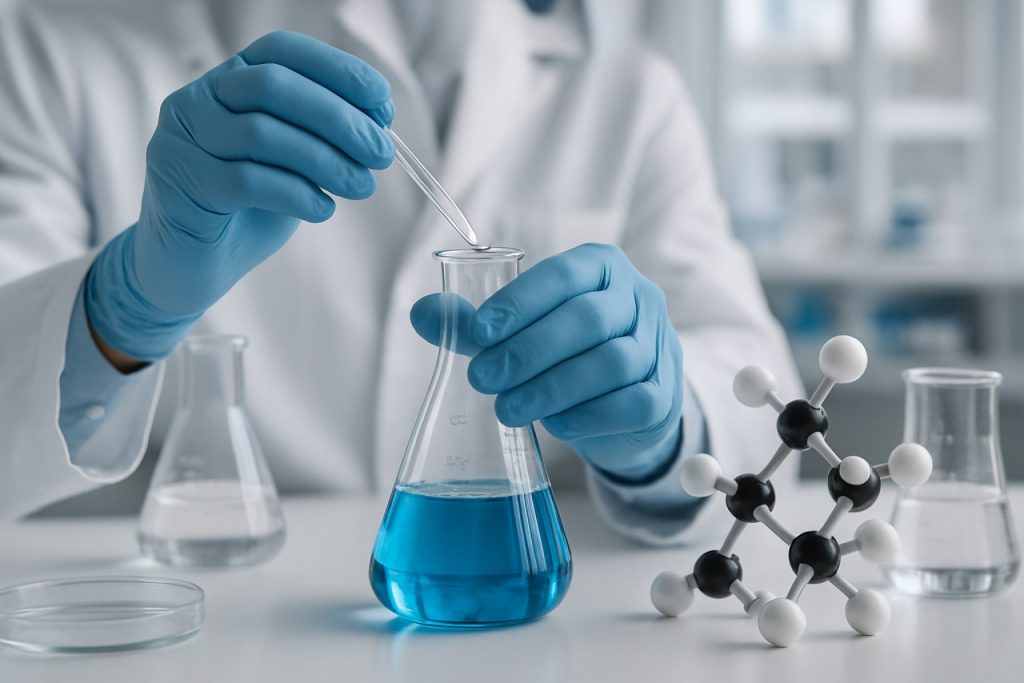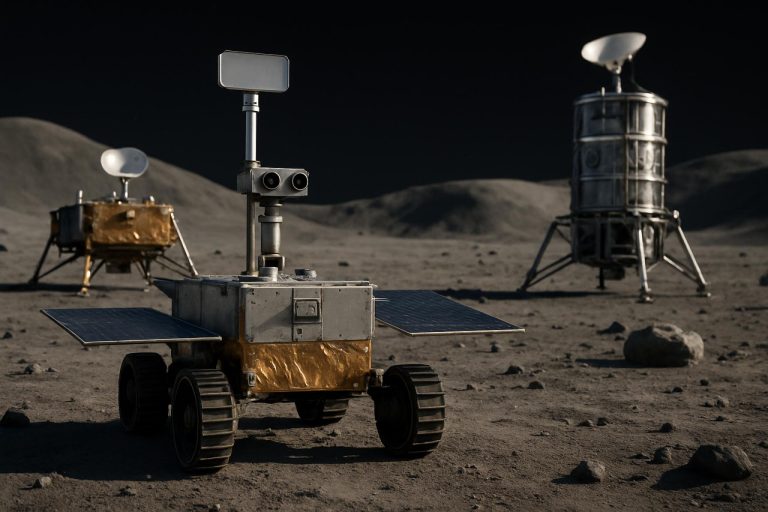
Chiral Pharmaceutical Synthesis in 2025: Unleashing Precision Chemistry for Next-Gen Drug Development. Explore How Innovation and Regulation Are Shaping a Rapidly Expanding Global Market.
- Executive Summary: Key Trends and Market Drivers in 2025
- Market Size, Growth Rate, and Forecasts Through 2030
- Technological Innovations: Catalysts, Biocatalysis, and Flow Chemistry
- Regulatory Landscape and Quality Standards (FDA, EMA, ICH)
- Competitive Landscape: Leading Companies and Strategic Alliances
- Applications in Drug Discovery and Commercial Manufacturing
- Sustainability and Green Chemistry Initiatives
- Regional Analysis: North America, Europe, Asia-Pacific, and Emerging Markets
- Challenges: Scalability, Cost, and Enantiomeric Purity
- Future Outlook: Disruptive Technologies and Market Opportunities
- Sources & References
Executive Summary: Key Trends and Market Drivers in 2025
Chiral pharmaceutical synthesis remains a cornerstone of the global pharmaceutical industry, with 2025 marking a period of accelerated innovation and strategic investment. The demand for single-enantiomer drugs continues to rise, driven by regulatory pressures for improved efficacy and safety, as well as the expiration of patents on blockbuster chiral drugs. The market is witnessing a shift toward more sustainable and cost-effective synthesis methods, including biocatalysis and asymmetric catalysis, which are increasingly being adopted by leading manufacturers.
Major pharmaceutical companies such as Novartis, Pfizer, and Roche are investing heavily in chiral synthesis technologies to support their pipelines of next-generation therapeutics, particularly in oncology, central nervous system disorders, and cardiovascular diseases. These companies are leveraging both in-house R&D and strategic partnerships with specialized contract development and manufacturing organizations (CDMOs) to accelerate the development and commercialization of chiral active pharmaceutical ingredients (APIs).
The adoption of green chemistry principles is a defining trend in 2025, with companies such as BASF and Lonza leading the way in implementing environmentally friendly chiral synthesis processes. Biocatalysis, in particular, is gaining traction due to its ability to deliver high enantioselectivity under mild conditions, reducing waste and energy consumption. This aligns with broader industry goals to minimize environmental impact and comply with increasingly stringent regulatory requirements in major markets.
Technological advancements are also shaping the competitive landscape. The integration of artificial intelligence and machine learning into process development is enabling faster optimization of chiral synthesis routes, as seen in initiatives by Merck KGaA and Thermo Fisher Scientific. These tools are expected to further reduce time-to-market for new chiral drugs and enhance process efficiency.
Looking ahead, the outlook for chiral pharmaceutical synthesis is robust. The sector is poised for continued growth, supported by a strong pipeline of chiral drug candidates and ongoing investments in advanced manufacturing technologies. As regulatory agencies maintain their focus on enantiopure drug development, and as sustainability becomes a non-negotiable standard, companies that can deliver high-quality, cost-effective, and environmentally responsible chiral synthesis solutions are expected to capture significant market share in the coming years.
Market Size, Growth Rate, and Forecasts Through 2030
The global market for chiral pharmaceutical synthesis is experiencing robust growth, driven by the increasing demand for enantiomerically pure drugs, regulatory emphasis on single-enantiomer formulations, and ongoing innovation in asymmetric synthesis technologies. As of 2025, the market size is estimated to be in the multi-billion-dollar range, with projections indicating a compound annual growth rate (CAGR) of approximately 8–10% through 2030. This expansion is underpinned by the rising prevalence of chronic diseases, the growing pipeline of chiral active pharmaceutical ingredients (APIs), and the continued shift from racemic mixtures to single-enantiomer drugs.
Key players in the chiral pharmaceutical synthesis sector include major contract development and manufacturing organizations (CDMOs) and chemical suppliers such as BASF, Evonik Industries, and Lonza. These companies have made significant investments in expanding their chiral synthesis capabilities, including the development of advanced catalytic and biocatalytic processes. For example, Evonik Industries has focused on enzymatic and chemoenzymatic synthesis routes, which offer higher selectivity and sustainability, while BASF continues to innovate in chiral intermediates and ligands for pharmaceutical applications.
The market is also shaped by the activities of specialized suppliers such as Almac Group and CordenPharma, both of which provide custom chiral synthesis and scale-up services for pharmaceutical clients worldwide. These organizations are responding to the increasing complexity of drug molecules and the need for efficient, scalable, and regulatory-compliant chiral manufacturing solutions.
Geographically, North America and Europe remain the largest markets for chiral pharmaceutical synthesis, owing to the presence of leading pharmaceutical companies, strong regulatory frameworks, and advanced R&D infrastructure. However, the Asia-Pacific region—particularly China and India—is expected to witness the fastest growth through 2030, fueled by expanding pharmaceutical manufacturing capacity and increasing investments in chiral technology platforms by companies such as WuXi AppTec and Dr. Reddy’s Laboratories.
Looking ahead, the market outlook for chiral pharmaceutical synthesis remains highly positive. The continued introduction of new chiral drugs, advances in asymmetric catalysis and biocatalysis, and the integration of green chemistry principles are expected to further accelerate market growth. Strategic collaborations, capacity expansions, and technology licensing agreements among leading players will likely shape the competitive landscape through 2030, ensuring that chiral synthesis remains a cornerstone of pharmaceutical innovation.
Technological Innovations: Catalysts, Biocatalysis, and Flow Chemistry
The landscape of chiral pharmaceutical synthesis is undergoing rapid transformation in 2025, driven by technological innovations in catalysts, biocatalysis, and flow chemistry. These advances are crucial for the efficient, sustainable, and cost-effective production of enantiomerically pure active pharmaceutical ingredients (APIs), which are increasingly demanded by regulatory agencies and the market.
Catalyst development remains at the forefront of chiral synthesis. Homogeneous and heterogeneous asymmetric catalysts, particularly those based on transition metals such as ruthenium, rhodium, and iridium, continue to be refined for higher selectivity and turnover numbers. Companies like BASF and Evonik Industries are investing in proprietary ligand and catalyst systems that enable more efficient asymmetric hydrogenations and C–C bond-forming reactions. These innovations are not only improving yields but also reducing the environmental footprint of pharmaceutical manufacturing by minimizing waste and energy consumption.
Biocatalysis is experiencing a surge in adoption, with enzyme engineering and immobilization technologies enabling the use of tailored biocatalysts for complex chiral transformations. Novozymes and DuPont are prominent players, offering a broad portfolio of enzymes for enantioselective synthesis. In 2025, the integration of machine learning and directed evolution is accelerating the discovery of novel enzymes with enhanced activity and selectivity, further expanding the scope of biocatalytic processes. These advances are particularly impactful for the synthesis of chiral amines, alcohols, and epoxides, which are key building blocks in many pharmaceuticals.
Flow chemistry is another area witnessing significant growth, as continuous processing offers advantages in scalability, safety, and process control. Companies such as Lonza and Sartorius are actively developing modular flow reactors and integrated systems for chiral synthesis. Flow chemistry enables precise control over reaction parameters, facilitating the use of highly reactive intermediates and hazardous reagents in a safer and more efficient manner. In 2025, the combination of flow chemistry with in-line analytics and automation is enabling real-time optimization and quality assurance, which is critical for meeting stringent regulatory requirements.
Looking ahead, the convergence of these technological innovations is expected to further streamline chiral pharmaceutical synthesis. The next few years will likely see increased collaboration between chemical, biotech, and equipment manufacturers to develop integrated solutions that address both technical and regulatory challenges. As the demand for single-enantiomer drugs continues to rise, these advances will play a pivotal role in shaping the future of pharmaceutical manufacturing.
Regulatory Landscape and Quality Standards (FDA, EMA, ICH)
The regulatory landscape for chiral pharmaceutical synthesis is evolving rapidly in 2025, reflecting the increasing complexity and importance of chirality in drug safety and efficacy. Regulatory agencies such as the U.S. Food and Drug Administration (FDA), the European Medicines Agency (EMA), and the International Council for Harmonisation of Technical Requirements for Pharmaceuticals for Human Use (ICH) continue to refine and enforce guidelines that address the unique challenges of chiral drug development and manufacturing.
The FDA maintains a strong focus on the characterization and control of stereoisomers in new drug applications. The agency’s guidance emphasizes the need for comprehensive analytical methods to distinguish and quantify enantiomers, as well as robust process controls to ensure enantiomeric purity throughout the manufacturing lifecycle. In 2025, the FDA is expected to further integrate advanced analytical technologies, such as chiral chromatography and real-time process monitoring, into its expectations for regulatory submissions, reflecting the growing adoption of these tools in industry.
Similarly, the EMA has reinforced its requirements for the demonstration of enantiomeric purity and the assessment of pharmacological and toxicological profiles of individual enantiomers. The agency’s guidelines, aligned with ICH Q6A and Q11, require detailed documentation of chiral synthesis routes, impurity profiles, and control strategies. The EMA is also increasingly scrutinizing the environmental impact of chiral synthesis, particularly regarding the use of hazardous reagents and the generation of chiral waste, in line with the European Union’s broader sustainability initiatives.
The ICH continues to play a central role in harmonizing global standards for chiral pharmaceuticals. The ICH Q7 guideline on Good Manufacturing Practice (GMP) for Active Pharmaceutical Ingredients, and the Q11 guideline on the development and manufacture of drug substances, both address the need for control of stereochemistry in APIs. In 2025, ongoing ICH discussions are expected to yield further clarifications on the use of biocatalysis and asymmetric synthesis, reflecting the industry’s shift toward greener and more selective chiral technologies.
Looking ahead, regulatory agencies are anticipated to place greater emphasis on continuous manufacturing, real-time release testing, and digitalization of quality data for chiral APIs. Companies such as Novartis, Pfizer, and Merck KGaA are actively engaging with regulators to pilot advanced manufacturing platforms and digital quality systems, aiming to set new benchmarks for compliance and product quality in chiral pharmaceutical synthesis.
Competitive Landscape: Leading Companies and Strategic Alliances
The competitive landscape of chiral pharmaceutical synthesis in 2025 is characterized by a dynamic interplay between established multinational corporations, innovative specialty firms, and a growing number of strategic alliances. The sector is driven by the increasing demand for enantiomerically pure active pharmaceutical ingredients (APIs), as regulatory agencies and healthcare providers emphasize the safety and efficacy advantages of single-enantiomer drugs.
Among the global leaders, BASF continues to leverage its extensive expertise in asymmetric synthesis and chiral intermediates, supplying both custom and catalog chiral building blocks to pharmaceutical manufacturers worldwide. Evonik Industries is another major player, with a strong portfolio in chiral catalysts and biocatalysis, supporting both large-scale and niche API production. Lonza maintains a significant presence through its integrated CDMO (contract development and manufacturing organization) services, offering advanced chiral synthesis capabilities from early development to commercial scale.
Japanese companies such as Takeda Pharmaceutical Company and Sumitomo Pharma are notable for their in-house chiral technology platforms, often collaborating with academic institutions and technology providers to accelerate the development of proprietary chiral drugs. In the United States, Pfizer and Merck & Co. continue to invest in both internal R&D and external partnerships to access novel chiral synthesis methodologies, including flow chemistry and enzymatic processes.
Strategic alliances are increasingly shaping the sector. For example, partnerships between large pharmaceutical companies and specialized technology providers—such as those offering advanced biocatalysts or continuous manufacturing platforms—are becoming more common. These collaborations aim to reduce development timelines, improve yields, and lower the environmental footprint of chiral synthesis. Notably, Almac Group and AMPAC Fine Chemicals have established themselves as key CDMOs with expertise in complex chiral API synthesis, often working closely with both innovator and generic drug companies.
Looking ahead, the competitive landscape is expected to see further consolidation, with mergers and acquisitions likely as companies seek to expand their chiral technology portfolios and global reach. The rise of green chemistry and the integration of artificial intelligence in process optimization are anticipated to be major differentiators. Companies that can offer scalable, cost-effective, and sustainable chiral synthesis solutions will be well-positioned to capture market share in the coming years.
Applications in Drug Discovery and Commercial Manufacturing
Chiral pharmaceutical synthesis remains a cornerstone of modern drug discovery and commercial manufacturing, with its significance only increasing as the industry advances into 2025 and beyond. The demand for enantiomerically pure active pharmaceutical ingredients (APIs) is driven by the recognition that different enantiomers of a chiral drug can exhibit markedly distinct pharmacological effects, safety profiles, and metabolic pathways. Regulatory agencies worldwide, including the U.S. Food and Drug Administration (FDA) and the European Medicines Agency (EMA), continue to emphasize the importance of chiral purity in new drug applications, further propelling innovation in this field.
In 2025, the pharmaceutical sector is witnessing a surge in the adoption of advanced asymmetric synthesis and biocatalytic methods for chiral molecule production. Companies such as BASF and Evonik Industries are at the forefront, offering a broad portfolio of chiral intermediates and catalysts tailored for both small-molecule and biologic drug development. BASF has expanded its chiral amine and alcohol product lines, leveraging proprietary catalytic hydrogenation and enzymatic processes to meet the growing needs of pharmaceutical manufacturers. Similarly, Evonik Industries has invested in biocatalysis platforms, enabling the efficient and sustainable synthesis of complex chiral building blocks.
The integration of continuous flow chemistry and process intensification is another trend shaping chiral pharmaceutical synthesis. Lonza, a global contract development and manufacturing organization (CDMO), has implemented continuous manufacturing technologies to enhance the scalability and reproducibility of chiral API production. This approach not only reduces waste and energy consumption but also accelerates time-to-market for new therapeutics.
In drug discovery, the application of chiral synthesis is pivotal for the rapid generation of stereochemically diverse compound libraries. Merck KGaA and Thermo Fisher Scientific supply a wide array of chiral reagents and screening tools, supporting medicinal chemists in the identification and optimization of lead candidates with desired stereochemistry. These resources are essential for structure-activity relationship (SAR) studies and for minimizing the risk of late-stage failures due to stereochemical issues.
Looking ahead, the outlook for chiral pharmaceutical synthesis is robust. The continued rise of personalized medicine, the expansion of peptide and oligonucleotide therapeutics, and the increasing complexity of drug molecules are expected to drive further innovation. Strategic collaborations between pharmaceutical companies and technology providers, as well as ongoing investments in green chemistry and digital process control, will likely define the next phase of growth in this sector.
Sustainability and Green Chemistry Initiatives
Sustainability and green chemistry have become central themes in the evolution of chiral pharmaceutical synthesis, particularly as the industry faces increasing regulatory and societal pressure to minimize environmental impact. In 2025, leading pharmaceutical manufacturers and suppliers are accelerating the adoption of greener methodologies, focusing on reducing waste, energy consumption, and the use of hazardous reagents in the production of enantiomerically pure compounds.
A significant trend is the shift toward biocatalysis and enzymatic processes, which offer high selectivity under mild conditions and often use water as a solvent. Companies such as Novozymes and BASF are at the forefront, supplying tailored enzymes and biocatalytic solutions for asymmetric synthesis. These approaches not only improve atom economy but also reduce the need for toxic metal catalysts and harsh reaction conditions, aligning with the principles of green chemistry.
Another area of progress is the implementation of continuous flow chemistry, which enhances process efficiency and safety while minimizing solvent use and waste generation. Lonza and Evonik Industries have invested in flow chemistry platforms for chiral intermediates, enabling scalable and sustainable production. These technologies are increasingly being integrated into commercial manufacturing lines, with several new drug approvals in 2024 and 2025 citing continuous flow processes in their regulatory filings.
Solvent selection and recycling are also under scrutiny. Merck KGaA and Thermo Fisher Scientific are developing solvent management systems and offering greener solvent alternatives for chiral synthesis. These initiatives are supported by industry-wide collaborations, such as the American Chemical Society’s Green Chemistry Institute Pharmaceutical Roundtable, which brings together major players to share best practices and set sustainability benchmarks.
Looking ahead, the next few years are expected to see further integration of artificial intelligence and machine learning to optimize chiral synthesis routes for both efficiency and environmental impact. Companies like Zymergen are exploring data-driven approaches to enzyme engineering and process optimization, potentially accelerating the discovery of greener synthetic pathways.
Overall, the outlook for sustainable chiral pharmaceutical synthesis in 2025 and beyond is marked by collaborative innovation, regulatory alignment, and a clear industry commitment to reducing the ecological footprint of drug manufacturing. As these green chemistry initiatives mature, they are poised to become standard practice, driving both economic and environmental benefits across the pharmaceutical value chain.
Regional Analysis: North America, Europe, Asia-Pacific, and Emerging Markets
The global landscape for chiral pharmaceutical synthesis is rapidly evolving, with distinct regional dynamics shaping innovation, production, and market growth. As of 2025, North America, Europe, and Asia-Pacific remain the primary hubs, while emerging markets are increasingly contributing to both research and manufacturing capacities.
North America continues to lead in chiral pharmaceutical synthesis, driven by robust R&D investments, a mature regulatory environment, and the presence of major pharmaceutical companies. The United States, in particular, is home to industry leaders such as Pfizer, Merck & Co., and Bristol Myers Squibb, all of which have advanced chiral synthesis capabilities integrated into their drug development pipelines. The region benefits from a strong network of contract development and manufacturing organizations (CDMOs) like Catalent and Thermo Fisher Scientific, which offer specialized chiral synthesis services. Regulatory support from the U.S. Food and Drug Administration (FDA) for enantiomerically pure drugs further accelerates innovation and commercialization.
Europe maintains a significant role, particularly in the development of green and sustainable chiral synthesis technologies. Countries such as Germany, Switzerland, and the United Kingdom are home to global pharmaceutical giants like Roche, Novartis, and GSK, which invest heavily in asymmetric synthesis and biocatalysis. European CDMOs, including Lonza and Evotec, are recognized for their expertise in complex chiral molecule production. The European Medicines Agency (EMA) continues to emphasize the importance of chiral purity in new drug approvals, fostering ongoing research and process optimization.
Asia-Pacific is experiencing the fastest growth in chiral pharmaceutical synthesis, propelled by expanding manufacturing infrastructure and increasing R&D investments. China and India, in particular, have emerged as major players, with companies such as WuXi AppTec and Dr. Reddy’s Laboratories offering large-scale chiral synthesis and custom manufacturing services. Japan’s established pharmaceutical sector, led by firms like Takeda</a), continues to innovate in chiral drug development. Regional governments are supporting the sector through favorable policies and funding for advanced synthesis technologies.
Emerging markets in Latin America, Eastern Europe, and Southeast Asia are gradually increasing their presence in chiral pharmaceutical synthesis. While these regions currently focus on generic production and contract manufacturing, there is a clear trend toward investing in chiral technology transfer and local R&D capabilities. Partnerships with established global firms are expected to accelerate technology adoption and market integration over the next few years.
Looking ahead, the regional interplay of innovation, regulatory frameworks, and manufacturing capacity will continue to shape the global chiral pharmaceutical synthesis sector, with Asia-Pacific poised for the most significant expansion through 2025 and beyond.
Challenges: Scalability, Cost, and Enantiomeric Purity
Chiral pharmaceutical synthesis remains a cornerstone of modern drug development, but the sector faces persistent challenges in scalability, cost management, and achieving high enantiomeric purity—issues that are particularly acute as the industry moves through 2025 and anticipates further growth in the coming years. The demand for single-enantiomer drugs continues to rise, driven by regulatory expectations and the superior efficacy and safety profiles of enantiopure compounds. However, translating laboratory-scale chiral synthesis to industrial-scale production is fraught with technical and economic hurdles.
One of the primary challenges is the scalability of asymmetric synthesis methods. While many catalytic and biocatalytic processes demonstrate excellent selectivity and yield at the bench scale, their transfer to multi-ton manufacturing often reveals limitations in catalyst stability, substrate scope, and process robustness. For example, BASF and Evonik Industries, both major suppliers of chiral intermediates and catalysts, have invested heavily in process intensification and continuous flow technologies to address these issues. Despite these advances, the need for highly specialized equipment and the complexity of process optimization can drive up capital and operational expenditures.
Cost remains a significant barrier, particularly for active pharmaceutical ingredients (APIs) requiring high enantiomeric excess (ee). The use of expensive chiral ligands, rare metal catalysts, or proprietary enzymes can substantially increase production costs. Companies such as Novartis and Merck KGaA have reported ongoing efforts to develop more cost-effective chiral synthesis routes, including the use of recyclable catalysts and engineered biocatalysts that operate under milder conditions and with cheaper feedstocks. Nevertheless, the economic viability of these approaches is often case-dependent and subject to the scale and complexity of the target molecule.
Achieving and maintaining high enantiomeric purity is another persistent challenge. Regulatory agencies such as the FDA and EMA require rigorous control of enantiomeric excess, as even minor impurities can impact drug safety and efficacy. This necessitates robust analytical methods and, in many cases, additional purification steps such as chiral chromatography or crystallization, which further add to production costs and complexity. Companies like Solvias and Alfa Aesar (a Thermo Fisher Scientific brand) are recognized for their expertise in chiral analysis and separation technologies, supporting the industry’s need for reliable quality control.
Looking ahead, the sector is expected to see incremental improvements in process efficiency and cost reduction, driven by advances in catalyst design, process automation, and digitalization. However, the fundamental challenges of scalability, cost, and enantiomeric purity will remain central to the strategic priorities of pharmaceutical manufacturers and their technology partners through 2025 and beyond.
Future Outlook: Disruptive Technologies and Market Opportunities
The future of chiral pharmaceutical synthesis is poised for significant transformation, driven by disruptive technologies and evolving market opportunities. As of 2025, the pharmaceutical industry is intensifying its focus on the efficient and sustainable production of enantiomerically pure compounds, a necessity for the development of safer and more effective drugs. The demand for single-enantiomer drugs continues to rise, propelled by regulatory pressures and the growing recognition of the distinct pharmacological profiles of enantiomers.
One of the most promising technological advancements is the integration of biocatalysis and enzyme engineering into chiral synthesis. Companies such as Novozymes and BASF are at the forefront, developing tailored enzymes that enable highly selective and environmentally benign transformations. These biocatalytic processes are increasingly being adopted for both early-stage drug discovery and large-scale manufacturing, offering advantages in terms of selectivity, scalability, and reduced waste.
Flow chemistry is another disruptive technology gaining traction. By enabling continuous processing, flow chemistry enhances reaction control, safety, and scalability—critical factors for chiral synthesis. Evonik Industries and Lonza Group are investing in continuous manufacturing platforms that incorporate asymmetric catalysis and chiral resolution steps, aiming to streamline production and reduce costs.
The application of artificial intelligence (AI) and machine learning is also reshaping the landscape. AI-driven retrosynthetic analysis and process optimization are accelerating the identification of efficient chiral synthetic routes. Merck KGaA and Siemens are collaborating on digitalization initiatives that integrate AI with automated synthesis platforms, promising faster development cycles and improved reproducibility.
Market opportunities are expanding, particularly in the context of personalized medicine and the increasing prevalence of chiral active pharmaceutical ingredients (APIs) in therapeutic pipelines. The Asia-Pacific region, led by manufacturers such as Sun Pharmaceutical Industries and Dr. Reddy’s Laboratories, is emerging as a key hub for chiral API production, leveraging cost advantages and robust manufacturing infrastructure.
Looking ahead, the convergence of biocatalysis, flow chemistry, and digital technologies is expected to redefine chiral pharmaceutical synthesis. Companies that invest in these disruptive platforms are likely to capture significant market share, as the industry shifts toward greener, more efficient, and highly selective manufacturing paradigms. The next few years will likely see increased collaboration between technology providers, pharmaceutical manufacturers, and regulatory bodies to accelerate the adoption of these innovations and address the growing demand for chiral drugs worldwide.
Sources & References
- Novartis
- Roche
- BASF
- Thermo Fisher Scientific
- Evonik Industries
- Almac Group
- CordenPharma
- WuXi AppTec
- Dr. Reddy’s Laboratories
- DuPont
- Sartorius
- European Medicines Agency
- International Council for Harmonisation of Technical Requirements for Pharmaceuticals for Human Use
- Takeda Pharmaceutical Company
- Merck & Co.
- AMPAC Fine Chemicals
- Bristol Myers Squibb
- Catalent
- GSK
- Evotec
- Siemens



